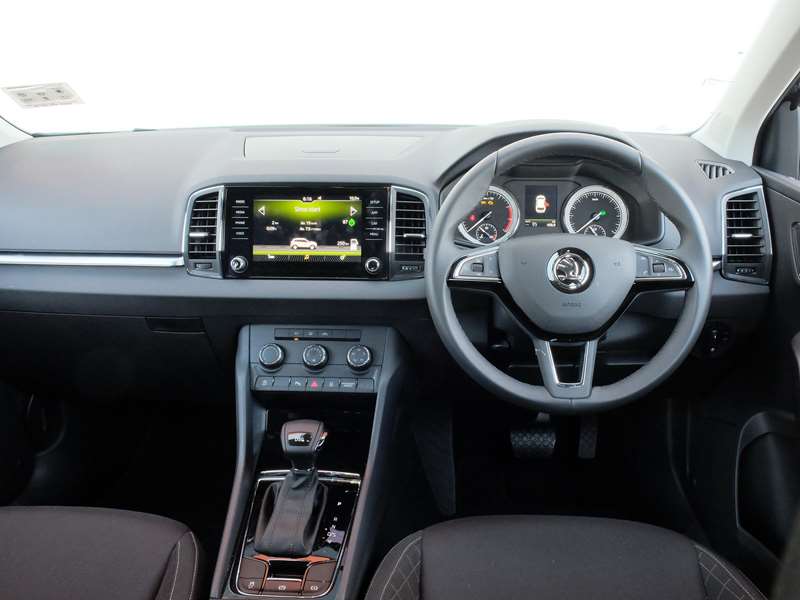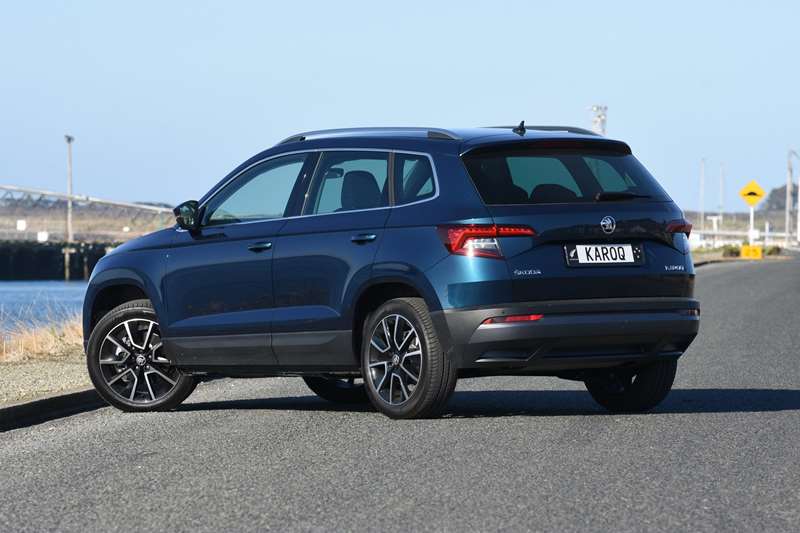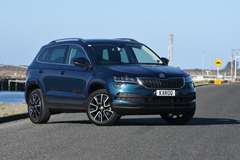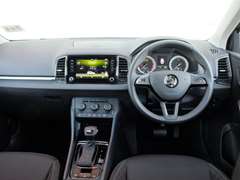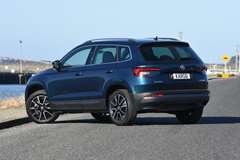| Price: | 38990 |
|---|---|
| Engine: | 1498 |
| Transmission: | Seven-speed direct shift gearbox, front-wheel drive |
| Brakes and stability systems: | Front and rear disc brakes, ABS, EBA, ESC, TC |
| Safety: | ★★★★★ |
| Wheels and tyres: | Alloy wheels, 215/50 R18 tyres |
| Fuel and economy: | 5.6 litres per 100km, capacity 50 litres |
| Emissions: | 123g COinf2/km |
| Dimensions: | Length 4382, width 2025, height 1603 |

What We Like
- Interior space
- refinement
- well-struck balance between ride and handling

What We Don't
- Lacks boldness of the Yeti
Verdict
The Karoq should lead the way for further Skoda sales growth
Rating:
Overview
David Thompson gets behind the wheel of the latest Skoda to hit the New Zealand market, the Karoq.
Skoda is an upwardly mobile brand in New Zealand right now, and the vehicle that is expected to carry the company’s fortunes further than any other over coming months is the new Karoq.
The Karoq has big shoes to fill within the Skoda family: firstly as successor to the Yeti, whose distinctive styling and fabulous interior has done much to establish Skoda’s identity in recent years; secondly, as the junior sibling to the Kodiaq, a larger SUV whose status as current New Zealand Car of the Year has been a feather in the cap for Skoda’s local image.
If you are seeking a sense of brand maturity, it’s certainly apparent in the Karoq’s looks. The weird quirkiness that marked the Yeti has been replaced by handsome styling,
anchored at the front by a nose that has much in common with the Kodiaq.
Slightly longer and wider than the Yeti, the Koroq’s obvious rivals span both the premium compact and mainstream mid-sized SUV crossover segments.
Skoda is keeping it relatively simple for now, offering just three models. Two of these — the $38,990 TSi Ambition Plus and $42,900 TSi Style — feature a 110kW/250Nm 1.5 litre petrol engine under the bonnet. The third is the $48,490 Style TDI flagship, powered by a 110kW/340Nm turbodiesel engine.
All three have a seven-speed DSG automated manual transmission, driving the front-wheels only on the Ambition Plus as tested, but all four wheels on the Style.
Opening the rear hatch of the test car to stow a couple of bags before getting behind the wheel, I was impressed by the capacious boot. Its capacity is an excellent 521 litres with the rear seats raised, and swells to 1810 litres when the split-folding rear seats are lowered.
Those rear seats provide ample head and legroom, though the squabs are a little bench-like.
Up front, the somewhat upright and angular set of the dash echoes the vehicle’s exterior styling, while the provision of soft touch upper surfaces, even on the entry-level model, is a nice feature. Combining this with subtle burnished and brush-metal highlighting and light-coloured trim on the door pillars and roof, and the test car delivered an appealing daytime interior ambience that was classy, light and airy. Driving at night, LED strip lighting in the cabin was equally appealing.
The front seats offer a command-style seating position, with the driver’s seat providing manual height and lumbar support adjustment. The steering column adjusts for rake and reach, the instrumentation is clear and key controls well located.
While the main glovebox is small, there’s additional lidded storage on the dash. Another handy little compartment at the base of the centre console contains 12-volt and chargeable USB power sockets, while dual cupholders and a modest lidded centre bin/armrest are located aft of the gear lever, between the front seats.
Considerably more standard equipment is provided on the Karoq Style, but the Ambition Plus has a reasonable standard specification. This includes 18-inch alloys, LED headlights, cornering lights, rain-sensing wipers and heated folding power mirrors.
Inside, the large, clear centre touchscreen gives access to the usual multimedia functions, including smart phone connectivity via the Android Auto, Apple Car Play and Mirror Link systems. There’s also a reversing camera with parking sensors, single-zone manual air-conditioning, push button start, cruise control, and a trip computer accessible via either the main centre display or the small digital display within the instrument binnacle.
The Karoq holds the maximum five-star safety rating, and the Ambition Plus comes with automatic emergency braking, lane assist, blind-spot monitoring and rear cross traffic alert systems as standard. Adaptive radar cruise control is a $950 option but, like several other optional extras for the Ambition Plus, comes as standard on the Style.
Platform-sharing is a big thing for the VW Group these days, with the Karoq using the same MLB underpinnings as the latest VW Golf and Porsche Macan.
Improved ride quality is a benefit that can be enjoyed equally around town and on the open road. As well as soaking up the bumps with aplomb, the test car demonstrated fine aural refinement. Engine noise hardly ever becomes intrusive within the cabin, and I have driven several far more expensive vehicles lately that fail to contain road noise as well as the Karoq.
Usually I am all for diesel and four-wheel drive as the right combination for SUV motoring in the lower South Island. While my instincts still lean that way, the Karoq test car made a strong case for petrol and front-drive as a sensible option for those who don’t venture off tarmac on anything but an occasional basis.
The turbo 1.5 petrol motor is tuned to provide maximum torque from just 1500rpm, and is responsive for around-town driving, yet can be quickly aroused from its highway cruising slumber to deliver snappy overtaking. Equipped with sport and manual modes, the DSG gearbox works well with the engine, allowing brisk acceleration off the mark before settling into a more relaxed shift protocol at higher speeds.
The standard cycle economy figure for the Karoq 1.5 TSI is an impressive 5.6 litres of fuel per 100km. While Drivesouth fell short of that on test, a 6.3l/100km return for the high portion of the road test and a 6.8l/100km for the entire test was still a worthy real-world result.

